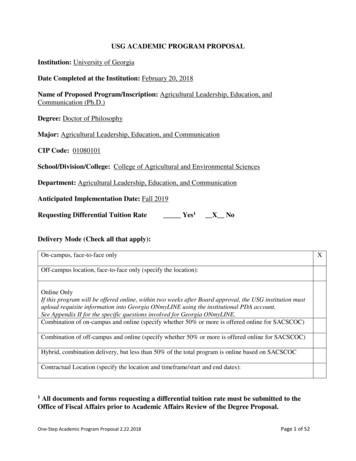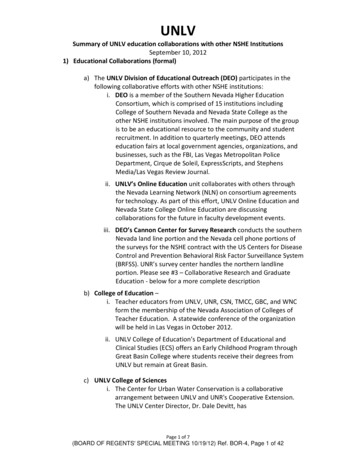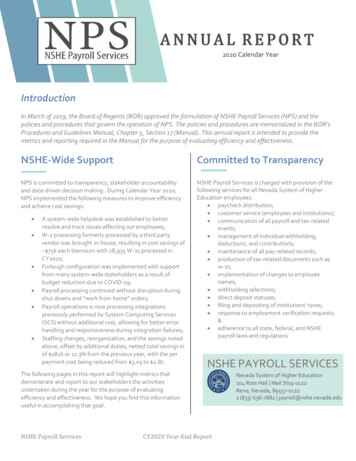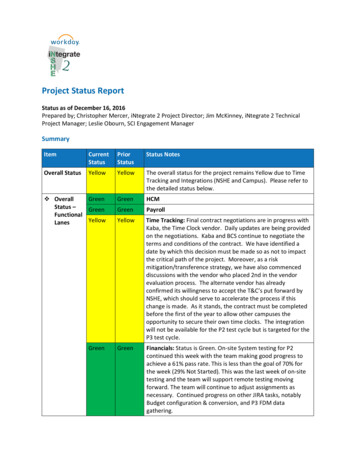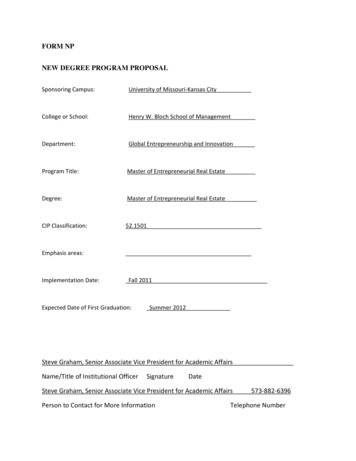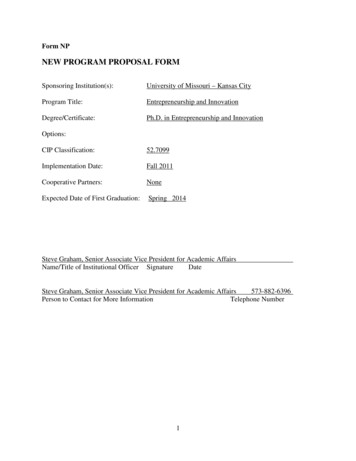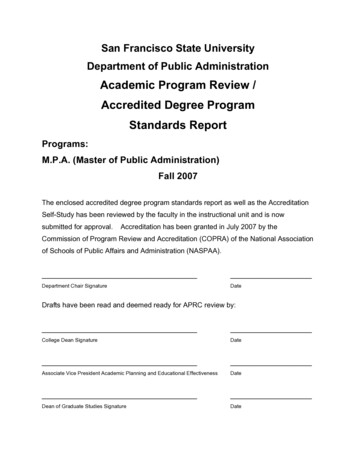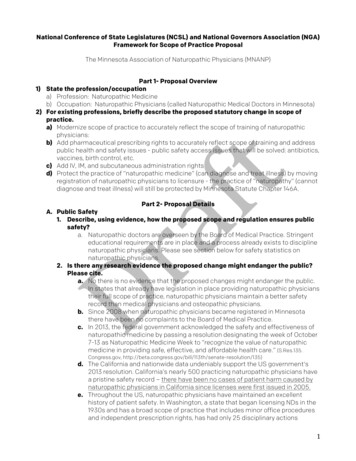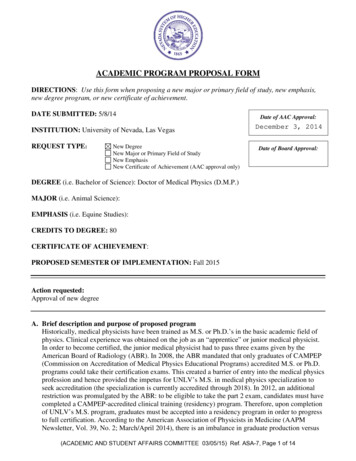
Transcription
ACADEMIC PROGRAM PROPOSAL FORMDIRECTIONS: Use this form when proposing a new major or primary field of study, new emphasis,new degree program, or new certificate of achievement.DATE SUBMITTED: 5/8/14INSTITUTION: University of Nevada, Las VegasREQUEST TYPE:New DegreeNew Major or Primary Field of StudyNew EmphasisNew Certificate of Achievement (AAC approval only)Date of AAC Approval:December 3, 2014Date of Board Approval:DEGREE (i.e. Bachelor of Science): Doctor of Medical Physics (D.M.P.)MAJOR (i.e. Animal Science):EMPHASIS (i.e. Equine Studies):CREDITS TO DEGREE: 80CERTIFICATE OF ACHIEVEMENT:PROPOSED SEMESTER OF IMPLEMENTATION: Fall 2015Action requested:Approval of new degreeA. Brief description and purpose of proposed programHistorically, medical physicists have been trained as M.S. or Ph.D.’s in the basic academic field ofphysics. Clinical experience was obtained on the job as an “apprentice” or junior medical physicist.In order to become certified, the junior medical physicist had to pass three exams given by theAmerican Board of Radiology (ABR). In 2008, the ABR mandated that only graduates of CAMPEP(Commission on Accreditation of Medical Physics Educational Programs) accredited M.S. or Ph.D.programs could take their certification exams. This created a barrier of entry into the medical physicsprofession and hence provided the impetus for UNLV’s M.S. in medical physics specialization toseek accreditation (the specialization is currently accredited through 2018). In 2012, an additionalrestriction was promulgated by the ABR: to be eligible to take the part 2 exam, candidates must havecompleted a CAMPEP-accredited clinical training (residency) program. Therefore, upon completionof UNLV’s M.S. program, graduates must be accepted into a residency program in order to progressto full certification. According to the American Association of Physicists in Medicine (AAPMNewsletter, Vol. 39, No. 2; March/April 2014), there is an imbalance in graduate production versus(ACADEMIC AND STUDENT AFFAIRS COMMITTEE 03/05/15) Ref. ASA-7, Page 1 of 14
residency opportunities that must be addressed to meet the manpower needs of the profession.Simply put, there are not enough residency programs to accommodate new medical physicsgraduates. This bottleneck has had a significant impact on M.S. degree holders, including UNLV’s,since residency programs tend to accept a larger percentage of Ph.D.s. This is not surprising sincemost residency programs are housed in academic institutions in which the program leadershipconsists of Ph.D. medical physicists who tend to prefer candidates with the same credentials asthemselves. Even so, the AAPM maintains that adequate didactic preparation for a clinical residencyis a two-year graduate program leading to a masters degree. One solution to this imbalance is tocreate a professional degree, i.e., a doctorate in medical physics (D.M.P.). Presently, there is onlyone CAMPEP-accredited D.M.P. program in the nation. In comparison, there are 70 accreditedresidency programs (as of Feb.1, 2014).Presently, there is a shortage of well-trained medical physicists which is likely to worsen over timeas there is increasing demand for medical physicists in radiation oncology, diagnostic imaging andnuclear medicine. This need has been driven primarily by the aging population and the developmentof new radiation sources and technologies. Additionally, approximately 50% of current medicalphysicists are over the age of 50 and therefore the demand is likely to increase in the coming decadesdue to retirement. From the preceding discussion, it is evident that there is a healthy job market formedical physics graduates, especially in the Mountain West region which is growing at a faster pacethan most other regions in the nation. In order to meet current demand, the AAPM estimates thataround 250-300 new medical physicists are needed per year in the U.S. This demand is not beingmet by the 70 residency programs which produce approximately 110 medical physicists per annum,most of whom are Ph.D. prepared.A D.M.P. program at UNLV would help to address the national shortage of residency programs. Theneed for such a program at UNLV is especially evident since it has been difficult for our M.S.graduates to gain acceptance into residency programs. An accredited D.M.P. program fulfills theresidency requirement as it provides two years of clinical training and thus will qualify our studentsto take all ABR certification exams. Without a D.M.P. program, it will become increasingly difficultto recruit students into the department’s medical physics option since we can’t offer the clinicaltraining required for full certification. UNLV’s M.S. in Health Physics: Medical Physics sub-plan isone of only two programs to receive CAMPEP accreditation without the involvement of a medicalschool. All other accredited educational programs have close ties to medical schools thus providingtheir students with easy access to residency programs. The D.M.P. curriculum will be almostidentical to the current M.S. program in the first two years of study and will consist of didacticcoursework and labs to provide students with the background knowledge required of a clinicalmedical physicist. The last two years of study will be spent in the clinic. Three clinics haveexpressed interest in affiliating with UNLV: Comprehensive Cancer Centers of Nevada (Las Vegas),Dixie Regional Medical Center in St. George, Utah and Kaiser Permanente in Los Angeles. We’re inpreliminary discussions with an additional two facilities (one in Hawaii, the other in Utah). This“hub-and-spoke” approach has been advocated by the AAPM and it fits into the community-orientedapproach that we have used for our imaging programs, i.e., sending students to local and regionalmedical facilities for their clinical education.B. Statement of degree or program objectivesThe educational objectives for the doctorate in medical physics program are as follows:1.2.3.To provide students with a comprehensive understanding of the fundamental principlesassociated with the clinical use of both ionizing and non-ionizing radiations.To provide students with an understanding of basic sectional anatomy and commonpathologies in medical imaging modalities including CT, MRI, ultrasound, and PET.To provide students with an in-depth knowledge of the operation of radiation producing and(ACADEMIC AND STUDENT AFFAIRS COMMITTEE 03/05/15) Ref. ASA-7, Page 2 of 14
4.5.6.7.8.9.detecting devices commonly used in therapeutic applications.To provide students with an understanding of the basic computational principles associatedwith therapeutic and diagnostic applications.To provide students with the clinical experience required for a complete understanding of thewide ranging clinical duties of a therapeutic medical physicist.To provide students with research experiences in medical physics-related projects.To produce graduates with a sound understanding of medical physics ethics and capable ofrendering appropriate clinical care to patients in a professional manner.To produce graduates capable of effectively communicating technical information in bothoral and written form.To produce graduates prepared to pursue a lifetime of self-directed learning and professionaldevelopment.C. Plan for assessment of degree or program objectivesPlanned assessment methods include:1.Quizzes and written exams. Students must obtain a grade of B or better in all courses.2.Oral exams. Students must achieve a rating of "satisfactory."3.National certification exam (ABR part 1). A 90 % pass rate will be considered a success.4.Clinical research project report. Students must obtain a grade of B or better.5.Student exit survey. A "satisfactory" evaluation in all categories will be considered asuccess. Based on scores and comments, an assessment will be made as to whether(a) the program met the student's expectations, and (b) the program adequately preparedthe student for a career in medical physics.6.Alumni survey. The goal is for the program to receive a "satisfactory" in all categories.D. Plan for assessment of student learning outcomes and the use of this data for programimprovementThe Program Director will be responsible for the analysis and reporting with input from dept. facultyand clinical preceptors. Performance of our graduates on the national board exam will be comparedwith the national average. A 90% pass rate on the national board exam (ABR part 1) will beconsidered a success (historically, the national pass rate for first takers is around 75%). A 100 %pass rate in all didactic courses (grade of B or better) will be considered a success. At the conclusionof each clinical rotation, students will be subjected to an oral exam (pass/fail) which will beadministered by the clinical preceptor and other medical physics staff with whom the student hasinteracted. A faculty representative from the dept. will also participate in the oral exam. The datawill be shared with all program faculty. Additionally, we will seek accreditation of the D.M.P.program (our M.S. in Medical Physics option is accredited by CAMPEP) and, as such, we would bemandated to share graduation rates, board exam results and placement rates with the general publicthrough our website.The program will be evaluated on an annual basis using the assessment instruments described inSection C. Curricular deficiencies will be identified and corrective action will be taken followingconsultation with program faculty and clinical preceptors. These discussions will be held duringregularly scheduled faculty and/or program meetings. At such meetings, the clinical preceptors willtypically participate via video or telephone conferencing. Students who fail a clinical rotation will beinformed of their deficiency (ies) and provided an opportunity to re-take the rotation.E. Contribution and relationship of program objectives toi. NSHE Master Plan(ACADEMIC AND STUDENT AFFAIRS COMMITTEE 03/05/15) Ref. ASA-7, Page 3 of 14
In the most recent Economic Development State Plan (2012-2014), Governor Sandovalennunciates a vision of developing "a vibrant, innovative, and sustainable economy" resulting in"high-quality jobs for Nevadans". This will be accomplishd through five objectives including"advancing targeted sectors and opportunities in the region." On p. 32 of the report, Health andMedical Services is featured prominently as a targeted sector, preceded only by Tourism,Gaming and Entertainment and Clean Energy. The overall objective of the D.M.P. program is toproduce highly skilled medical physicists that would address a current shortage of such healthcare professionals. Medical physicists are integral in the treatment of cancer patients and, assuch, the D.M.P. program will provide skilled healh care workers for local radiation oncologyfacilities and hospitals. The need for medical physicists is especially acute in Nevada due to theaging population and the resultant increase in the number of cancer patients requiring radiationtherapy during the management of their disease. Traditionally, it has been difficult to attractmedical physicists to Nevada. The proposed D.M.P. program addresses this issue by traininglocal area students who are more likely to stay and work in Nevada following graduation.ii. Institutional missionIn the first paragraph of UNLV’s Mission Statement it states that "We produce accomplishedgraduates who are well prepared to enter the work force, or to continue their education ingraduate and professional programs.” A D.M.P. program will provide a direct path tocertification and hence gainful employment in clinical medical physics. This will certainlypromote student learning and success (Core Theme #1). Furthermore, according to the MissionStatement: “Our commitment to our dynamic region and State centrally influences our researchand educational programs, which improves our local communities.” Las Vegas has a largepopulation of elderly individuals with pressing health care needs including radiation therapy. AD.M.P. program will help to address these needs by providing well trained medical physicists tostaff radiation oncology facilities. A D.M.P. program will promote significant engagement withthe community (Core Theme #3) since local hospitals and clinics will provide the clinicalexperience. This is a very familiar approach since the Department’s imaging programs(Radiography, Nuclear Medicine, and Comprehensive Medical Imaging) send their students tohospitals and clinics in the Las Vegas area. This community partnership has worked well as ithas provided students with clinical experience while also providing a steady source of potentialemployees for the imaging facilities. A D.M.P. program will certainly help foster engagementwith the community as new partnerships are developed with radiation oncology programs inlocal hospitals and free-standing facilities. According to the Mission Statement: “Ourcommitment to the national and international communities ensures that our research andeducational programs engage both traditional and innovative areas of study and globalconcerns.”D.M.P. programs are highly innovative, in fact, there is currently only one suchprogram in the nation. The establishment of a D.M.P. program will position UNLV as a leader inmedical physics education and will likely attract highly qualified applicants not only from theMountain West region, but the entire nation. Students in the D.M.P. program will be expected toparticipate in clinical research (Core Theme #2). This is significant since there have beenrelatively few clinical research projects at UNLV.iii. Campus strategic plan and/or academic master planThe University’s Master Plan includes the establishment of a Medical School. Although a UNLVMedical School is not essential for the survival of a D.M.P. program, it would certainly providemuch needed clinical infrastructure that would help to grow the program. Graduates of theprogram serve as a source of highly skilled medical professionals for the Medical School andlocal area hospitals/clinics with radiation oncology needs.iv. Department and college plan(ACADEMIC AND STUDENT AFFAIRS COMMITTEE 03/05/15) Ref. ASA-7, Page 4 of 14
In the Dept. of Health Physics Goals and Action Items, the number one goal is to “developadditional areas of concentration within the health physics and medical imaging area consistentwith the Department’s strengths.” In the most recent School of Allied Health Sciences strategicplan, the primary objective is to “enhance graduate educational and post-baccalaureateopportunities offered in the School.” As is evident, the development of the M.S. in HealthPhysics: Medical Physics sub-plan in 2009 supported both the Department’s and the School’sstrategic plans. The establishment of a D.M.P. program will certainly enhance graduateeducational opportunities and it is consistent with the Department’s strength in medical physics.A D.M.P. program will provide a direct path for students to obtain certification in medicalphysics and, hence increase their likelihood of obtaining employment in the field. The strategicplans provided the rationale for the recent hiring of two additional highly qualified, researchfocused medical physicists. These hires have made it possible to strengthen the medical physicsofferings in the Department and, hence to propose the establishment of a D.M.P program.v. Other programs in the institutionThe D.M.P. program will admit students with bachelors degrees in physics, or closely relateddisciplines (e.g. engineering and chemistry) and, as such, it will serve as a viable option forstudents in the physical sciences interested in obtaining a professional degree in the medicalsciences field. Over the past two years, UNLV's M.S. in Health Physics: Medical Physics subplan has admitted 3 graduates from the Physics Department. These students would have appliedfor admission to the D.M.P. program had such an option been available.vi. Other related programs in the SystemNotwithstanding UNLV's program, there are no medical physics programs of any kind in theNSHE System. Therefore, a D.M.P. program at UNLV would help to attract students from otherNSHE institutions, especially physics and engineering graduates from UNR.F. Evaluation of need for the programi. Intrinsic academic value of program within the disciplineIn order to alleviate the shortage of medical physics residencies, the professional association(AAPM) has been advocating for the establishment of D.M.P. programs as an alternativepathway to certification. At present, there is only one accredited D.M.P. program in the nation.Therefore an accredited D.M.P. program at UNLV would place it at the forefront of medicalphysics education and, as such, would help to attract highly qualified students to the University.ii. Evidence of existing or projected local, state, regional, national and/or international needfor programAs previously discussed, there are not enough residency programs to accommodate graduates ofmedical physics educational programs. Therefore, as an alternative approach to obtain clinicalexperience, the AAPM is encouraging the establishment of D.M.P. programs. This wouldcertainly help to alleviate the imbalance between the number of graduates looking for residencypositions and the number of available residencies. Presently, there's only one accredited D.M.P.program in the nation. Additional D.M.P. programs, such as proposed at UNLV, would certainlyhelp to address the shortage of well-trained medical physicists. This shortage is likely to worsendue to the rapid growth of the three major medical physics subspecialties. This increased demandis primarily due to the aging population and the development of new radiation sources andtechnologies. Furthermore, approximately 50% of current medical physicists are over the age of50 and, as such, the shortage is likely to worsen in the near future due to retirement.iii. If this or a similar program already exists within the System, what is the justification forthis addition(ACADEMIC AND STUDENT AFFAIRS COMMITTEE 03/05/15) Ref. ASA-7, Page 5 of 14
There are no other medical physics programs within the System.iv. Evidence of employment opportunities for graduates (state and national)No statistics were found for Medical Physics, or closely related professions on Nevada'sDepartment of Employment, Training and Rehabilitation website. Medical Physics is also notlisted in the Federal Government's Outlook Handbook. The U.S. Bureau of Labor Statistics statesthat it does not collect employment data for medical physicists and suggests consulting theprofessional organization, i.e., the AAPM. According to the March/April 2014 AAPMNewsletter larchive), in order to meetcurrent demand, approximately 150-180 new medical physicists are needed per year in the U.S.This demand is not being met by the 70 residency programs. To address the shortage, the articlerecommends the establishment of D.M.P. programs, especially those incorporating privatecommunity-based clinics/hospitals (the so-called "hub-and-spoke" model). This is exactly thetype of D.M.P. program that is being proposed at UNLV. Finally, due to the aging populationand the aging workforce, it is evident that there is a healthy job market for medical physicsgraduates, especially in the Mountain West region which is growing at a faster rate than mostother regions in the U.S. Unfortunately, there are no residency programs in the Mountain West.The vast majority of residency programs are located in the Eastern U.S.: there are only 17programs west of the Mississippi (primarily in Texas and California).v. Student clientele to be served (Explain how the student clientele is identified)Student recruitment will be accomplished primarily through CAMPEP's website which lists allaccredited educational programs (Certificate, M.S., Ph.D. and D.M.P.) and residencies. Stud
graduates. This bottleneck has had a significant impact on M.S. degree holders, including UNLV’s, since residency programs tend to accept a larger percentage of Ph.D.s. This is not surprising since most residency programs are housed
